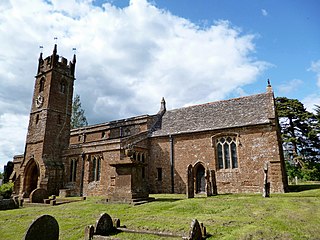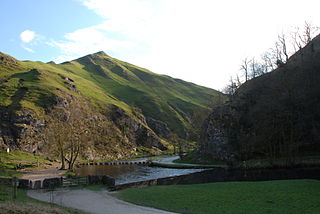The Lord High Chancellor of Ireland was the highest judicial office in Ireland until the establishment of the Irish Free State in 1922. From 1721 to 1801, it was also the highest political office of the Irish Parliament: the Chancellor was Speaker of the Irish House of Lords. The Lord Chancellor was also Lord Keeper of the Great Seal of Ireland. In all three respects, the office mirrored the Lord High Chancellor of Great Britain.
The Chancellor of the Exchequer of Ireland was the head of the Exchequer of Ireland and a member of the Dublin Castle administration under the Lord Lieutenant of Ireland in the Kingdom of Ireland. In early times the office was sometimes called the Chancellor of the Green Wax. In the early centuries, the Chancellor was often a highly educated cleric with knowledge of Finance. In later centuries, when sessions of Parliament had become regular, the Chancellor was invariably an MP in the Irish House of Commons.

Balscote or Balscott is a village in the civil parish of Wroxton, Oxfordshire, about 4 miles (6.4 km) west of Banbury. The Domesday Book of 1086 records the place-name as Berescote. Curia regis rolls from 1204 and 1208 record it as Belescot. An entry in the Book of Fees for 1242 records it as Balescot. Its origin is Old English, meaning the cottage, house or manor of a man called Bælli.

The Chief Baron of the Irish Exchequer was the Baron (judge) who presided over the Irish Court of Exchequer. This was a mirror of the equivalent court in England, and was one of the four courts which sat in the building in Dublin which is still called The Four Courts.

Alexander de Balscot, also known as Alexander Petit was one of the leading Irish clerics and statesmen of the late fourteenth century, who held the offices of Bishop of Ossory, Bishop of Meath, Treasurer of Ireland and Lord Chancellor of Ireland.
Walter de Thornbury was an English-born statesman and cleric in 14th century Ireland who held the office of Lord Chancellor of Ireland. His efforts to secure confirmation of his election as Archbishop of Dublin were ended in tragedy with his death in a shipwreck.
Sir Robert Dowdall was an Irish judge who held the office of Chief Justice of the Irish Common Pleas for more than forty years. He is mainly remembered today for the murderous assault on him by Sir James Keating, the Prior of Kilmainham, in 1462.
Thomas de Montpellier, or de Monte Pessulano was a fourteenth-century Anglo-French judge and Crown official, much of whose career was spent in Ireland. He held a number of important lay and clerical offices including Dean of St. Patrick's Cathedral, Chancellor of the Exchequer of Ireland and, briefly, Chief Baron of the Irish Exchequer.

Thomas de Everdon was an English-born cleric and judge, who was a trusted Crown official in Ireland for several decades.
John de Burnham, or John Brunham was an English-born cleric, judge and Crown official who spent much of his career in Ireland. He held office as Lord High Treasurer of Ireland and Chief Baron of the Irish Exchequer. He spent many years defending himself against charges of corruption, which seem to have been the invention of malicious colleagues.
Robert de Emeldon, or Embleton was an English-born Crown official and judge who spent much of his career in Ireland. He held several important public offices, including Attorney-General for Ireland, Lord High Treasurer of Ireland and Chief Baron of the Irish Exchequer. He was a turbulent and violent man, who was guilty of at least one homicide, was imprisoned for a number of serious crimes including rape and manslaughter, and had a reputation for corruption: but he was a royal favourite of King Edward III and was thus able to survive his temporary disgrace in the early 1350s.
Robert le Poer was an Irish judge and Crown official who held the offices of Lord High Treasurer of Ireland and Chief Baron of the Irish Exchequer.
Henry Mitchell (c.1320–1384) was an Irish judge of the fourteenth century. He was one of the first recorded holders of the office of Attorney General for Ireland, and was subsequently Chief Baron of the Irish Exchequer and Chief Justice of the Irish Common Pleas.
John de Grauntsete or Grantsete (or John of Grantchester) (c. 1270 – c. 1350) was an English judge who lived in fourteenth-century Ireland. We know more about him than we do about any other contemporary Irish judge, and from the surviving information we can form some idea of the lifestyle of an Irish judge in his time. He sat in turn in each of the Irish Courts of common law, and uniquely he is known to have appeared in Court as an advocate even after he became a judge.

Thomas Dowdall, also spelt Dowdale, Douedall, or Dowedall, was an Irish barrister and judge who held the office of Master of the Rolls in Ireland.

William de Bardelby was an English-born judge in Ireland.
Thomas Archbold, or Thomas Galmole was a goldsmith and silversmith, who also qualified as a lawyer, and rose to become a senior Crown official and judge in Ireland in the late fifteenth and early sixteenth centuries. He was Master of the Mint in Ireland for many years.
Edward Somerton, or Somertoune was an Irish barrister and judge who held the offices of Serjeant-at-law (Ireland) and judge of the Court of King's Bench (Ireland) and the Court of Common Pleas (Ireland). He was born in Ireland, possibly in Waterford, although he lived much of his life in Dublin. By 1426 he was a clerk in the Court of Chancery (Ireland), and was paid 26 shillings for his labours in preparing writs and enrolment of indentures,. In 1427 he is recorded in London studying law at Lincoln's Inn. He returned to Ireland and was again in the Crown service by 1435, when he was ordered to convey lands at Beaulieu, County Louth to Robert Chambre, one of the Barons of the Court of Exchequer (Ireland). He was appointed King's Serjeant for life in 1437; he also acted as counsel for the city of Waterford, a position subsequently held by another future judge, John Gough.
Richard le Brun was an English-born cleric, judge and Crown official in fourteenth-century Ireland. He was Chief Baron of the Irish Exchequer 1319-1324.
John Blakeney was an Irish judge of the fifteenth century, who served three times as Chief Justice of the Common Pleas.






